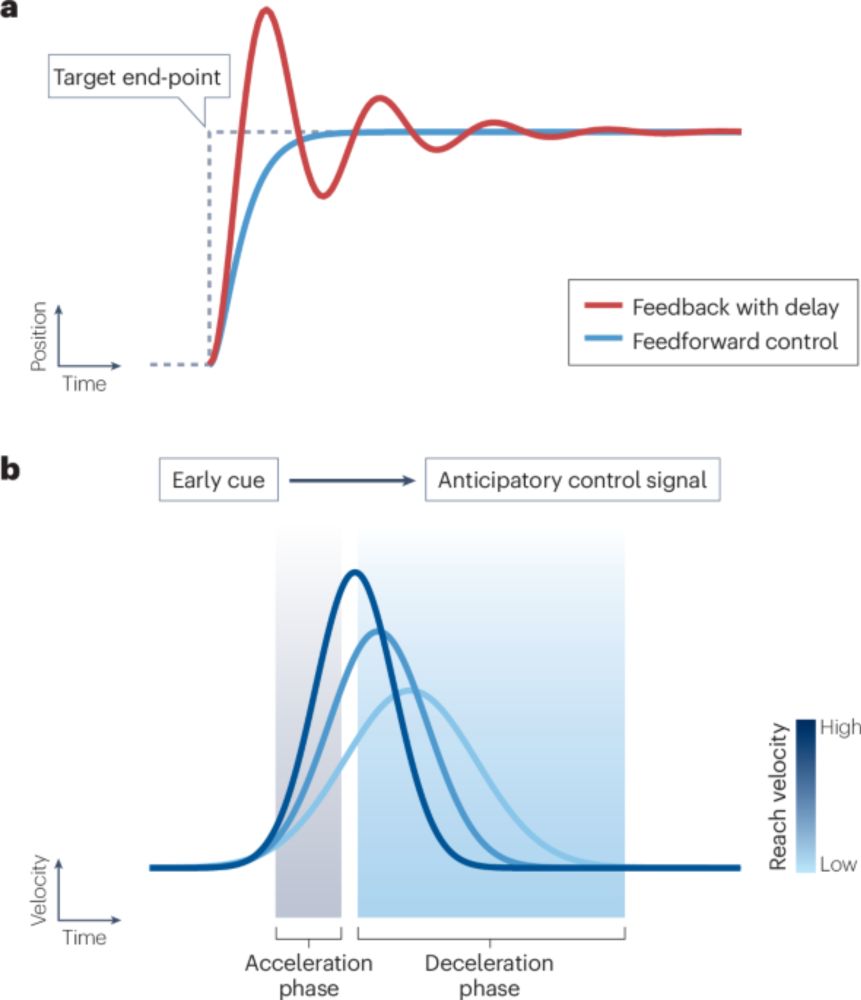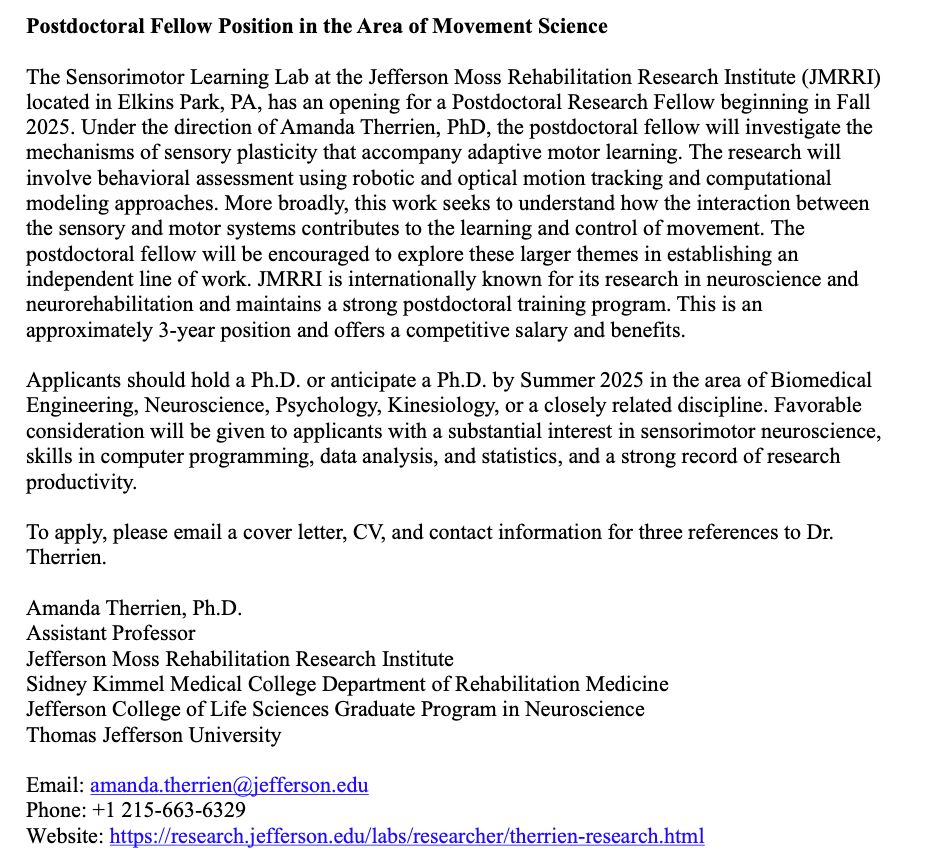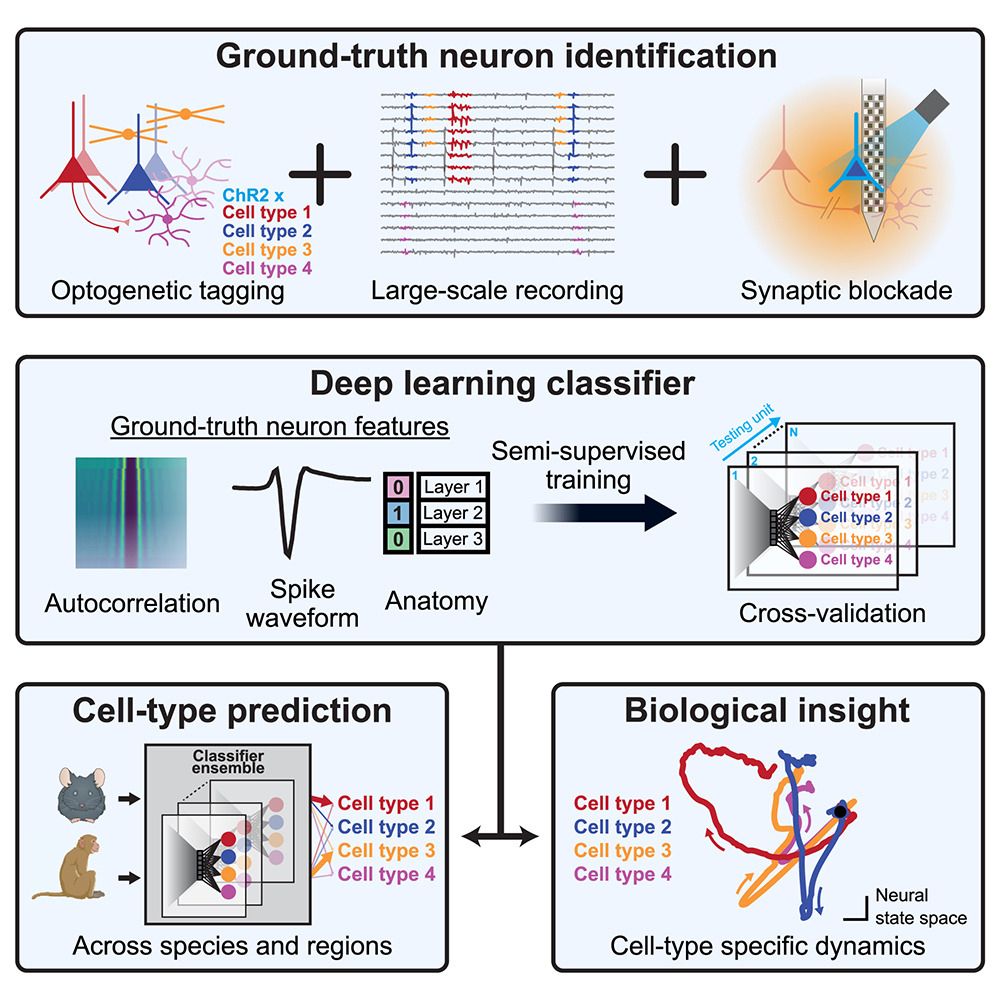
Of potential interest to those keen on motor control and/or multi-task networks. Congrats to Elom and Eric.
www.biorxiv.org/content/10.1...
@dherzneuro.bsky.social
Assistant Professor of Neuroscience at UW-Madison | herzfeldlab.neuro.wisc.edu | Views are my own

Of potential interest to those keen on motor control and/or multi-task networks. Congrats to Elom and Eric.
www.biorxiv.org/content/10.1...
The Anne West lab at Duke is hiring a postdoc to work on nuclear cell biology in neurogenesis. Please help me spread the word! Applications to west@neuro.duke.edu.
27.07.2025 20:27 — 👍 58 🔁 51 💬 1 📌 2
Cerebellar circuit computations for predictive motor control — a Review by Katrina P. Nguyen & Abigail L. Person
www.nature.com/articles/s41...
#neuroscience #neuroskyence
I feel very lucky in this regard - I will have already hired a fantastic lab manager with 10+ years NHP experience, and who seems to be willing to stay (fingers crossed) for the long haul!
Can't ask for better.
But I also need additional "hands" (beyond mine) to do the science.
My point exactly. I'm not sure how long to wait for the "right person" given that some portion of my startup expires soon-ish (3+ years).
08.06.2025 22:43 — 👍 0 🔁 0 💬 0 📌 0This is fantastic advice!
For whatever reason, I feel obligated to hire someone quickly if I put out an ad - obviously not the case (given my faculty interviews...!).
It sounds like the message is to put out multiple ads and wait for the best person/fit.
I received similar advice, but not sure how I can reasonably hire people if I can't guarantee them a long(ish) term position.
My PIs have been very generous with timelines. I would like to be similarly in a position to keep good people - especially when timing for their next position is unknown.
We have to explicitly advertise for a particular position (only post-doc/tec).
I would love to just evaluate based on fit and talent, but at least at the "professional" level, I have to explicitly specify the level/experience/salary.
So, multiple calls? But no commitments to hiring?
My established scientists, two incredibly "new PI" questions:
1. How do you figure out how many people to hire/can hire? What's the math based on $ in account and when those $ expire?
2. How do you figure out your ratio of techs, grad students, and post-docs? Is it project or budget based?

Full job posting for a postdoc position at the Jefferson Moss Rehabilitation Research Institute.
POSTDOC JOB OPENING. My lab at @mossresearch.bsky.social has an opening for a postdoc fellow to work with @aaronlwong.bsky.social and me on an NSF-funded research program studying mechanisms of sensory plasticity that accompany adaptive motor learning. The full posting is below. Please share!
16.04.2025 18:29 — 👍 27 🔁 26 💬 3 📌 2Come work with us! Amanda is a fantastic advisor, and we have some really exciting studies planned!
16.04.2025 23:08 — 👍 8 🔁 4 💬 0 📌 0Are you an ambitious scientist or engineer?
Do you want to do hard engineering that will transform lives and advance science?
Come join us to build next-generation neurotechnology at Integral.
I believe there was an update today (3/3/25)! The announcement is currently listed as "pending," scheduled to be officially posted 3/4. It lists review meetings for the DP2, Transformative Research Awards, and PBKD.
Link here: www.federalregister.gov/public-inspe...

I am very proud to announce that my PhD paper finally came out in Cell! In this *very* collaborative study, we develop and release a deep-learning approach to predict neuron type identity from their electrical signature. doi.org/10.1016/j.ce... 1/16 🧵
01.03.2025 13:14 — 👍 151 🔁 42 💬 3 📌 2We think that our approach can be generalized to other brain areas - allowing links from neurons to circuits to behavior.
And...our automated tool can be used right now by other cerebellar researchers!
We certainly learned lots of lessons from this paper (e.g., need for standardizing pre-processing across labs and incredibly careful data curation, necessity of pharmacological blockade for opto-tagging in cerebellum, nearly complete inability to record granule cells using conventional probes).
28.02.2025 16:50 — 👍 2 🔁 0 💬 1 📌 1
We are very excited to see our collaborative paper on classification of neuron types in the cerebellum (across species!) now published in Cell.
www.cell.com/cell/fulltex...
This was a huge project, spanning multiple labs - across continents - and a huge team effort!
Thanks, Andrew!
23.02.2025 19:01 — 👍 0 🔁 0 💬 0 📌 0And - another personal plug: I am setting up my lab at UW-Madison this summer (herzfeldlab.neuro.wisc.edu). I am looking for people passionate about linking circuit computations to behavior in primates! (6/6)
23.02.2025 17:12 — 👍 17 🔁 7 💬 1 📌 0We hope that this work inspires others to perform similar circuit dissection analyses in other regions of the cerebellum (and beyond)! (5/6)
23.02.2025 17:12 — 👍 1 🔁 0 💬 1 📌 0Along the way, we demonstrate the requisite properties of granule cell responses (a cerebellar neuron whose activity is invisible to current multi-contact electrodes). (4/6)
23.02.2025 17:12 — 👍 1 🔁 0 💬 1 📌 0Using these neuron-identification tools, we characterize the input-output computations performed by the cerebellum and go on to show how (and where) the cerebellar circuit implements these computations. Long-story short, the cerebellum implements temporal and directional transformations. (3/6)
23.02.2025 17:12 — 👍 1 🔁 0 💬 1 📌 0We take advantage of some new tools we developed to distinguish neuron types within the cerebellum from extracellular recordings (doi.org/10.1101/2025... & doi.org/10.1101/2024...) in a region that is crucial for the execution of smooth eye movements (the floccular complex). (2/6)
23.02.2025 17:12 — 👍 1 🔁 0 💬 1 📌 0
I'm thrilled to share our new *NIH funded* paper (doi.org/10.1101/2025...) describing the circuit-level computations performed by the cerebellum during eye movements in primates. (1/6)
23.02.2025 17:12 — 👍 34 🔁 5 💬 1 📌 0Strategies to decipher neuron identity from extracellular recordings in the cerebellum of behaving non-human primates https://www.biorxiv.org/content/10.1101/2025.01.29.634860v1
29.01.2025 22:15 — 👍 3 🔁 1 💬 0 📌 0AND...I am setting up my new lab at UW-Madison (herzfeldlab.neuro.wisc.edu) this summer! If you are interested in linking cell types and neural circuits to computation - please reach out! (4/4)
29.01.2025 23:21 — 👍 19 🔁 6 💬 3 📌 0Together, these two manuscripts are allowing us to ask new questions about the foundational cerebellar circuit processes that transform information during behavior. Stay tuned for those new results! (3/4)
29.01.2025 23:21 — 👍 1 🔁 0 💬 1 📌 0
These methods are the behind-the-scenes efforts that allowed our recent collaborative paper (www.biorxiv.org/content/10.1...) to build and evaluate a deep-learning classifier for cerebellar cell types across species. Our classifier paper should be in press soon!! (2/4)
29.01.2025 23:21 — 👍 2 🔁 0 💬 1 📌 0
Excited to share a new preprint (www.biorxiv.org/content/10.1...) where we describe methods for identifying cerebellar neuron types from extracellular recordings in NHPs. With knowledge of the circuit and some new insights, we can establish neuron type for a large fraction of recorded neurons. (1/4)
29.01.2025 23:21 — 👍 16 🔁 4 💬 2 📌 0New preprint! A collaborative effort of multiple labs showing the ability to link extracellular recordings to underlying neuron identities (using the cerebellum as an example). Really excited to see how others can use these methods to gain a deeper understanding of how circuits link to behavior!
01.02.2024 20:29 — 👍 8 🔁 1 💬 1 📌 0